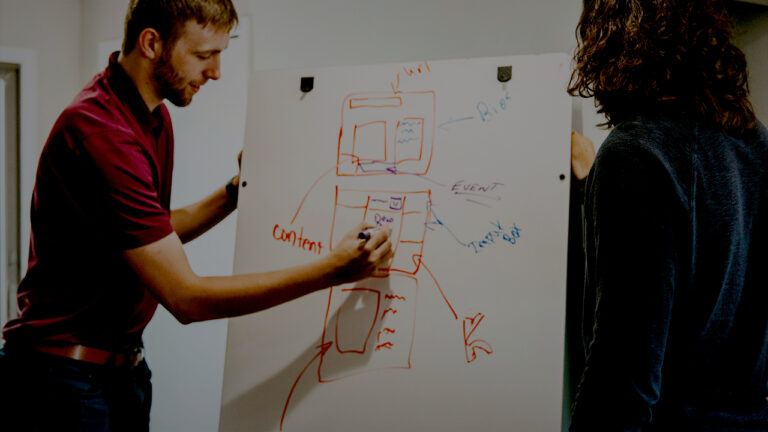Let’s talk about new product development.
The journey into the unknown to explore the future of a category, generate innovative solutions, develop a winning product market strategy… and grow a business.
An experience that feels fast. Intense. Overwhelming. A bit like the wild west. But, also rewarding when you remember why you are developing new products in the first place… to solve real problems, for real people!
“How can I create new product ideas If I don’t know where to start?” you may ask. Great question.
Let’s answer that by unpacking how to go about new product development, and exploring:
- What people-centric product development is
- Who to have on your product development team
- The 7-steps of the product development process
- Answers to frequently asked questions
…So that you can feel more prepared for your next rodeo.
First, what is people-centric product development?
Product development is the process through which companies conceive, design, and bring new products or services to the market. It involves a series of strategic steps, including ideation, design, testing, and refinement.
When you search for “stages of new product development” you’ll find plenty of lists, most of which start with idea generation. However, people-centric product development starts with understanding people first, with several touch points throughout the entire journey to ensure that people stay at the heart of what we do.

So, who should you have on your team for people-centric product development?
Product development requires a cross-functional team that stays along for every stage, which can include:
- Project Lead: Coordinates and oversees the project timeline, ensuring tasks are completed on schedule
- Insights Lead: Acts as the voice of the customer, keeping core insights about your target’s needs and wants at the forefront of everyone’s minds, at every stage
- Brand and Marketing Leads: Develops strategies to promote and launch the product effectively in the market
- Product Management Lead: Leads the overall product strategy, ensuring alignment with business goals and customer needs
- R&D Teams, Designers (UI/UX), Developers: Create the visual and user experience elements of the product, focusing on aesthetics and usability. Build the technical aspects of the product, translating design concepts into functional features
- …To name a few! You may also need representatives from legal or compliance teams, finance, mergers and acquisitions
Not only do you need the right roles, you need the right personalities. Product development is a dynamic and constantly evolving journey that can be ambiguous at times, and often demands a certain level of courage to leave the safety of the status quo. Having the right people in the room who can adapt and flex will help you get further, faster.
7-stages of the product development process
You have your team and are ready to go. Now, let’s take a look at the 7 steps of product development, and how they look when you make them more people centric.

Vision-Setting
Get clear on what the business goal for innovation is. Is it to win among a new target audience, enter a new category, adapt to new market realities? What guardrails or constraints can we use to set up parameters for this project?
While this isn’t what makes it people-centric, it’s a bit part of staying on track, versus spinning your wheels.
Insider Tip: While big, broad ambitions are admirable, the best innovations come from laser sharp focus and clarity. Focus just as much effort on defining what’s out of bounds, as you would defining what’s within bounds.
Discovery
This is where a traditional 7-stage product development process becomes more people-centric. Rather than jumping right into idea generation, take a step back to get a holistic picture of the market. To do so, consider using a model called the 4Cs: Culture, Category, Consumer, Company. Not only does it help you understand people and their needs, it helps paint a broader picture of their surrounding context, and the dynamics at play.
Each of these “Cs” intersect with the others, and at the center of it all will be our opportunities for innovation. By the end of this process, you should have an idea of the opportunity space(s) that you want to focus on for new product development. Let’s unpack them:
Culture:
Explore what’s happening in culture and define the macro forces that are impacting people today. Explore big topics, such as social and economic issues that can impact your category, and the people you want to target.
What to use: Trend research, expert interviews (e.g. futurists, journalists, academic leaders) news in your market/region.
Category:
Dive deep into category trends, and do a competitive analysis to see what brands in your space, and in adjacent categories, are doing (or, not doing) as a result of these trends to identify potential opportunities and threats.
What to use: Category publications, competitor’s websites, annual reports and marketing, recent conference buzz, category-specific experts who can give you insights that you wouldn’t typically find in a Google search.
Consumer:
Do primary research to better understand your target audience. Who are they, what are their lives like? How do they feel about your category, and what are their biggest unmet needs and problems to solve? Are there gaps your competitors are not addressing?
What to use: Primary research, including digital diaries, ethnographies, interviews and group discussions are great ways to uncover people’s unmet needs. You might also consider quantitative research, if you need a foundational view of sizable motivations and jobs. Or, You might even consider doing both.
Company:
Assess your own company’s strengths and weaknesses. What do you do well that you can further amplify with innovation? What weaknesses can new product innovation address?
What to use: Previous SWOT analyses, brand health trackers, and other research – as well as one-on-ones with key stakeholders, to learn more about their perspectives, hypotheses, and insights that might not be found as easily in past reports.

Insider tip: The most important part of this process – talking to real, live people. Desk research is critical, but it’s conversations with stakeholders, experts and customers early in the process that will have the greatest impact on this phase.
Ideation
Now’s the time to immerse the teams in insights, and workshop new product ideas that could solve real problems, for real people! Workshops can be one day or many, however most usually take this flow:
Immerse teams:
Share insights from the vision-setting and discovery phases, landing the white space opportunities you want to focus on.
Start with divergent exercises:
Draft exercises that will help teams think creatively about the problem. For instance, how might another brand outside your category solve it? (e.g. how would Starbucks approach the sneaker business?)
Then, convergent exercises:
Zero in on your top ideas. Think about whether the idea truly solves a need, is disruptive, feels future-proof, or even feasible and scalable, and narrow down.
Insider tip: Workshop in-person off-site if possible to avoid getting stuck in old thinking, and into a new mindset. Bring in stimuli (real, physical products, from even beyond your category) to get people thinking.
Refinement
Once you have your top ideas from the workshop, share your ideas with your target audience to capture their feedback. To do this, you can field
- Live discussion groups
- Quick-turn quantitative survey with open ends
- Qual at quant scale with a platform like Remesh.
The goal is to refine ideas (or, deprioritize them) before investing in full concept testing, so it’s alright for them to be a little rougher at this stage. A sentence with the benefit and some example features should do the trick!
Insider tip: Consider bringing your teams together with real people who represent your target, in a live session (no backroom)! Not only will you hear feedback straight from the source, you’ll also be able to iterate and co-create together. We promise they don’t bite.
Evaluation
Next, turn your ideas into full fledged product concepts. These are descriptions that outline what the product is, who it’s for, the core benefit, plus key features and reasons to believe. These concepts also have 3D renderings that bring them to life. You can use a service like NielsenIQ BASES to evaluate which concepts have the greatest promise, and which may need refinement.
Insider tip: Simplify, simplify, simplify. The best concepts articulate benefits in clear, single-minded ways. One concept = one benefit!
Planning & Prototyping
Plan:
Planning happens once you know which concepts have the greatest promise. Your plan is an outline of what you’ll need to do to bring this product to life.
- Part of your plan will be outlining how the product will be produced –from sourcing materials, finding manufacturers, for instance.
- You will also need to develop a product marketing strategy, using your insights from earlier phases of research, coupled with data across your business – including how you will position, price and promote your product.
Prototype:
Next, you’ll create a minimal viable product (MVP) that can be tested to ensure it works, and that it effectively solves people’s needs. The most important part – ensuring that it’s tested in real-world conditions. Making a shoe? Have people actually walk, run and jump in it at the gym.
Insider tip: Work in stages to get more specific feedback as you go, rather than general feedback toward the end (which can help avoid a lot of heartbreak, too!)
Development and Commercialization
Development:
This is where the rubber meets the road – use insights from prototyping to make final tweaks to your product before it goes into production.
Commercialization:
The final stage, where you introduce your products to the market. This is when you create marketing plans to drive awareness and interest– and ultimately motivate people to purchase your product!
Insider tip: Embrace feedback after launch. While this is the final stage, it’s only the beginning of the customer’s journey, and they may have thoughts on how the next version could be even better. That’s a good thing, and critical to more people-centric product development.
Product development FAQ
What is a minimum viable product?
A Minimum Viable Product (MVP) is a version of a new product that includes only the essential features needed to meet the initial requirements of the customer, and is meant to gather feedback and validate assumptions about viability before full production.
What is the difference between product management and product development?
- Product management is responsible for developing the overall product strategy (including defining customer needs to solve), setting goals and steering all product teams toward crafting a marketable product, along with the product roadmap.
- Product development focused on the ideation and formation of a new product within the product life cycle. This process entails devising a distinct product strategy to transform an idea into reality.
- Collectively, product management and product development teams work together to launch a new product – and both do best when they are people centric.
How can the risk of product development be reduced?
Using a more people-centric product development process helps mitigate risk by weaving in more touchpoints with your target audience throughout the process. By including your customer in stages like discovery and refinement, evaluation and prototyping, you’ll be able to course correct before launch, and develop products that solve real problems for real people.
If you can’t tell, we love this kind of stuff at The Sound. New product development is a huge part of how brands connect with people – so it’s only natural that people are a part of the process, and understanding people is how we get to possibilities.
Ready to get started? Have questions?


